child restraint FIAT BARCHETTA 2003 1.G Owners Manual
[x] Cancel search | Manufacturer: FIAT, Model Year: 2003, Model line: BARCHETTA, Model: FIAT BARCHETTA 2003 1.GPages: 170, PDF Size: 3.55 MB
Page 25 of 170
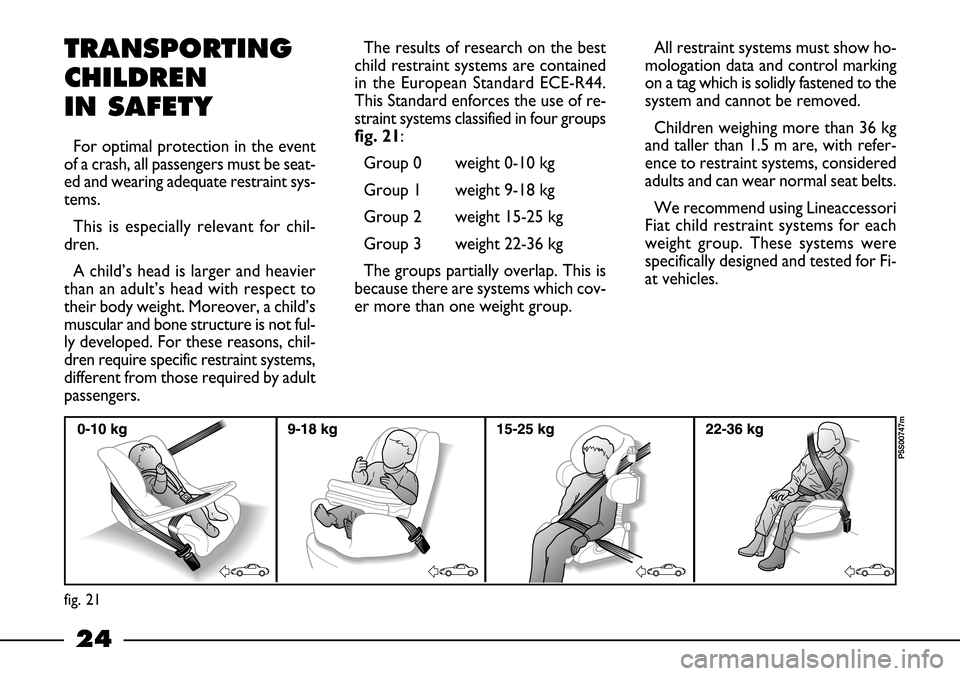
24
TRANSPORTING
CHILDREN
IN SAFETY
For optimal protection in the event
of a crash, all passengers must be seat-
ed and wearing adequate restraint sys-
tems.
This is especially relevant for chil-
dren.
A child’s head is larger and heavier
than an adult’s head with respect to
their body weight. Moreover, a child’s
muscular and bone structure is not ful-
ly developed. For these reasons, chil-
dren require specific restraint systems,
different from those required by adult
passengers.The results of research on the best
child restraint systems are contained
in the European Standard ECE-R44.
This Standard enforces the use of re-
straint systems classified in four groups
fig. 21:
Group 0 weight 0-10 kg
Group 1 weight 9-18 kg
Group 2 weight 15-25 kg
Group 3 weight 22-36 kg
The groups partially overlap. This is
because there are systems which cov-
er more than one weight group.All restraint systems must show ho-
mologation data and control marking
on a tag which is solidly fastened to the
system and cannot be removed.
Children weighing more than 36 kg
and taller than 1.5 m are, with refer-
ence to restraint systems, considered
adults and can wear normal seat belts.
We recommend using Lineaccessori
Fiat child restraint systems for each
weight group. These systems were
specifically designed and tested for Fi-
at vehicles.
fig. 21
P5S00747m
Page 26 of 170
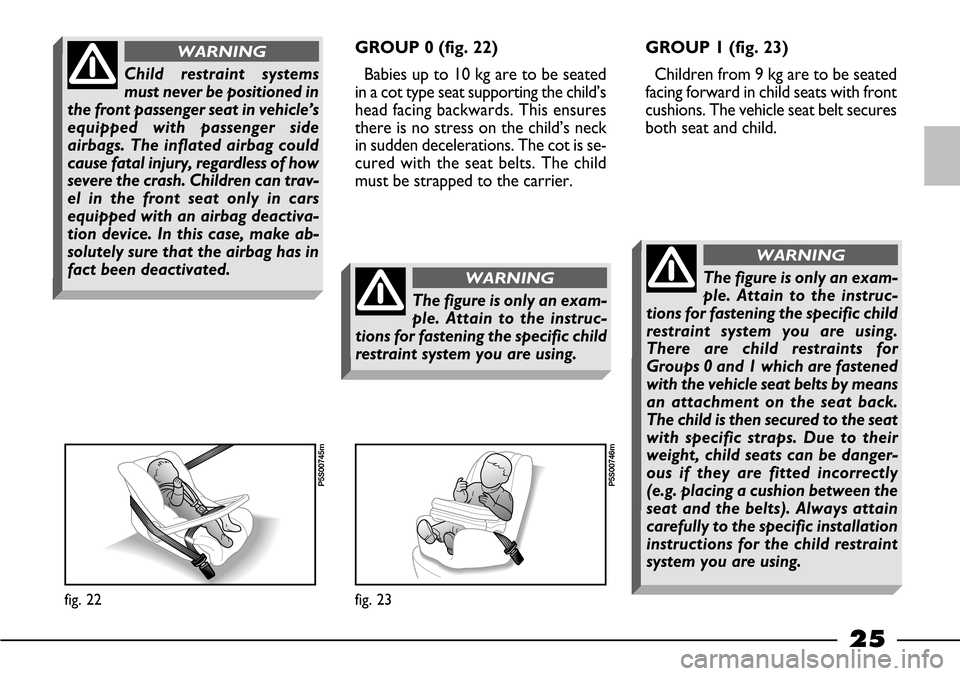
25
GROUP 0 (fig. 22)
Babies up to 10 kg are to be seated
in a cot type seat supporting the child’s
head facing backwards. This ensures
there is no stress on the child’s neck
in sudden decelerations. The cot is se-
cured with the seat belts. The child
must be strapped to the carrier.GROUP 1 (fig. 23)
Children from 9 kg are to be seated
facing forward in child seats with front
cushions. The vehicle seat belt secures
both seat and child.
fig. 22
P5S00745m
fig. 23
P5S00746m
Child restraint systems
must never be positioned in
the front passenger seat in vehicle’s
equipped with passenger side
airbags. The inflated airbag could
cause fatal injury, regardless of how
severe the crash. Children can trav-
el in the front seat only in cars
equipped with an airbag deactiva-
tion device. In this case, make ab-
solutely sure that the airbag has in
fact been deactivated.
WARNING
The figure is only an exam-
ple. Attain to the instruc-
tions for fastening the specific child
restraint system you are using.
WARNINGThe figure is only an exam-
ple. Attain to the instruc-
tions for fastening the specific child
restraint system you are using.
There are child restraints for
Groups 0 and 1 which are fastened
with the vehicle seat belts by means
an attachment on the seat back.
The child is then secured to the seat
with specific straps. Due to their
weight, child seats can be danger-
ous if they are fitted incorrectly
(e.g. placing a cushion between the
seat and the belts). Always attain
carefully to the specific installation
instructions for the child restraint
system you are using.
WARNING
Page 27 of 170
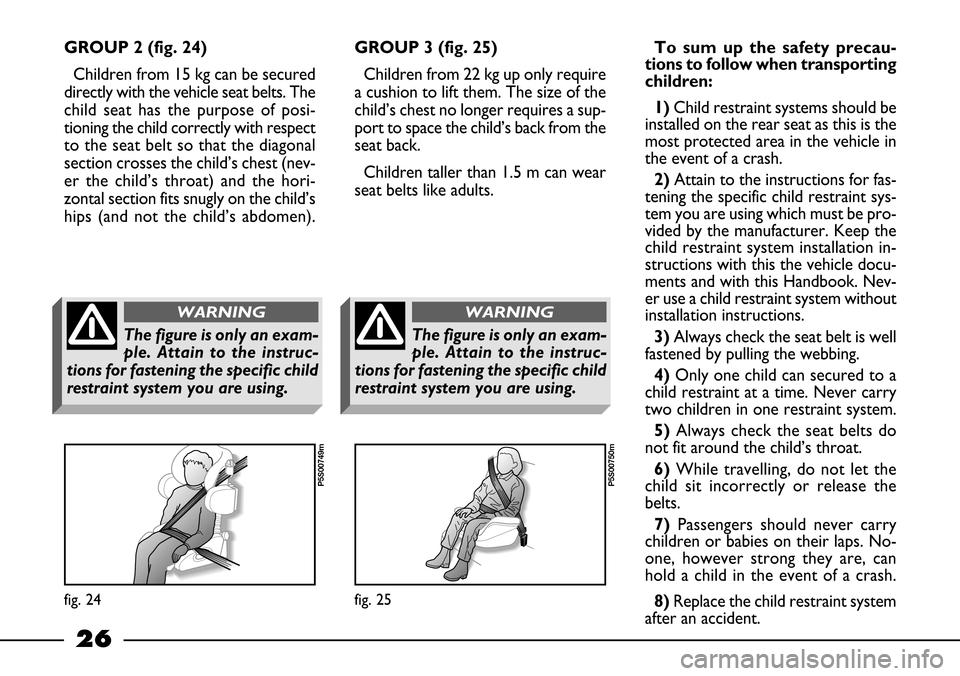
26
GROUP 2 (fig. 24)
Children from 15 kg can be secured
directly with the vehicle seat belts. The
child seat has the purpose of posi-
tioning the child correctly with respect
to the seat belt so that the diagonal
section crosses the child’s chest (nev-
er the child’s throat) and the hori-
zontal section fits snugly on the child’s
hips (and not the child’s abdomen). GROUP 3 (fig. 25)
Children from 22 kg up only require
a cushion to lift them. The size of the
child’s chest no longer requires a sup-
port to space the child’s back from the
seat back.
Children taller than 1.5 m can wear
seat belts like adults.To sum up the safety precau-
tions to follow when transporting
children:
1) Child restraint systems should be
installed on the rear seat as this is the
most protected area in the vehicle in
the event of a crash.
2) Attain to the instructions for fas-
tening the specific child restraint sys-
tem you are using which must be pro-
vided by the manufacturer. Keep the
child restraint system installation in-
structions with this the vehicle docu-
ments and with this Handbook. Nev-
er use a child restraint system without
installation instructions.
3) Always check the seat belt is well
fastened by pulling the webbing.
4) Only one child can secured to a
child restraint at a time. Never carry
two children in one restraint system.
5) Always check the seat belts do
not fit around the child’s throat.
6) While travelling, do not let the
child sit incorrectly or release the
belts.
7)Passengers should never carry
children or babies on their laps. No-
one, however strong they are, can
hold a child in the event of a crash.
8) Replace the child restraint system
after an accident.
fig. 24
P5S00749m
fig. 25
P5S00750m
The figure is only an exam-
ple. Attain to the instruc-
tions for fastening the specific child
restraint system you are using.
WARNING
The figure is only an exam-
ple. Attain to the instruc-
tions for fastening the specific child
restraint system you are using.
WARNING
Page 60 of 170
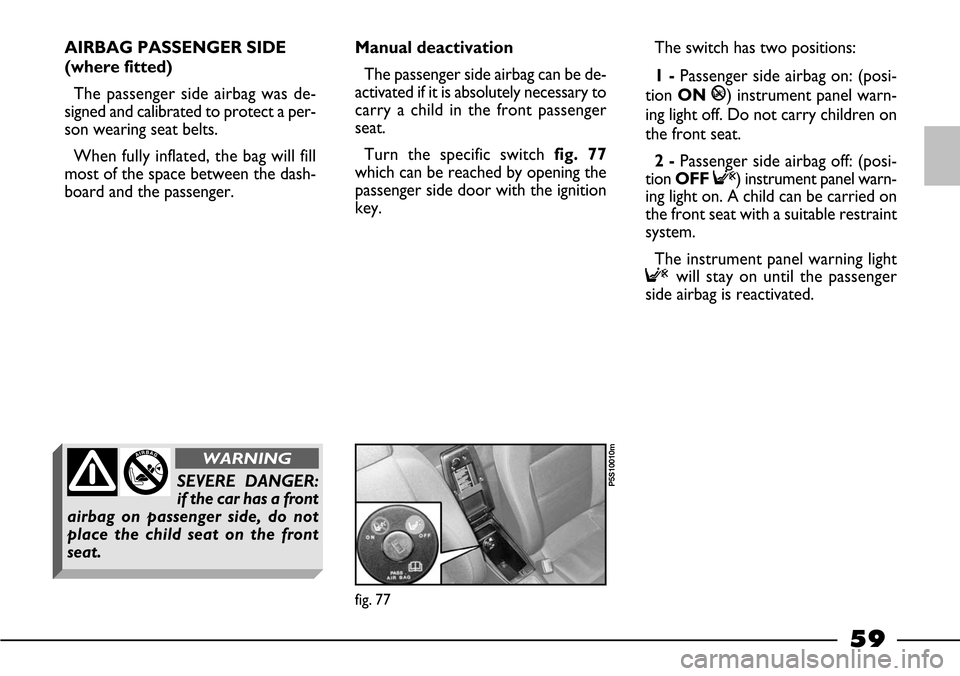
59
AIRBAG PASSENGER SIDE
(where fitted)
The passenger side airbag was de-
signed and calibrated to protect a per-
son wearing seat belts.
When fully inflated, the bag will fill
most of the space between the dash-
board and the passenger. Manual deactivation
The passenger side airbag can be de-
activated if it is absolutely necessary to
carry a child in the front passenger
seat.
Turn the specific switch fig. 77
which can be reached by opening the
passenger side door with the ignition
key. The switch has two positions:
1 - Passenger side airbag on: (posi-
tion ON
P) instrument panel warn-
ing light off. Do not carry children on
the front seat.
2 -Passenger side airbag off: (posi-
tion OFFF) instrument panel warn-
ing light on. A child can be carried on
the front seat with a suitable restraint
system.
The instrument panel warning light
Fwill stay on until the passenger
side airbag is reactivated.
SEVERE DANGER:
if the car has a front
airbag on passenger side, do not
place the child seat on the front
seat.
WARNING
fig. 77
P5S10010m
Page 73 of 170
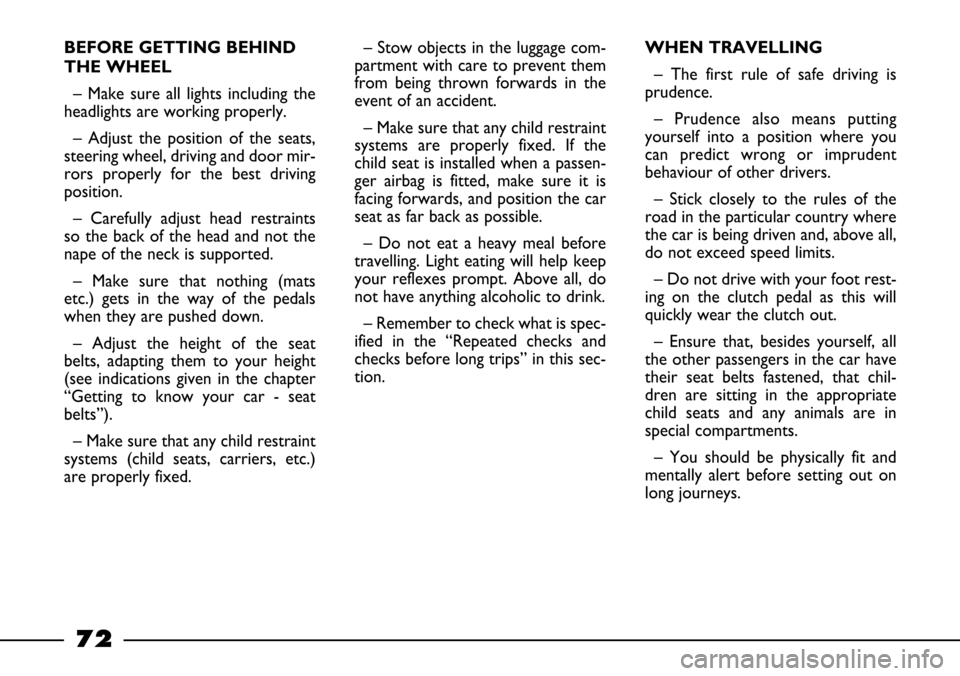
72
BEFORE GETTING BEHIND
THE WHEEL
– Make sure all lights including the
headlights are working properly.
– Adjust the position of the seats,
steering wheel, driving and door mir-
rors properly for the best driving
position.
– Carefully adjust head restraints
so the back of the head and not the
nape of the neck is supported.
– Make sure that nothing (mats
etc.) gets in the way of the pedals
when they are pushed down.
– Adjust the height of the seat
belts, adapting them to your height
(see indications given in the chapter
“Getting to know your car - seat
belts”).
– Make sure that any child restraint
systems (child seats, carriers, etc.)
are properly fixed.– Stow objects in the luggage com-
partment with care to prevent them
from being thrown forwards in the
event of an accident.
– Make sure that any child restraint
systems are properly fixed. If the
child seat is installed when a passen-
ger airbag is fitted, make sure it is
facing forwards, and position the car
seat as far back as possible.
– Do not eat a heavy meal before
travelling. Light eating will help keep
your reflexes prompt. Above all, do
not have anything alcoholic to drink.
– Remember to check what is spec-
ified in the “Repeated checks and
checks before long trips” in this sec-
tion.WHEN TRAVELLING
– The first rule of safe driving is
prudence.
– Prudence also means putting
yourself into a position where you
can predict wrong or imprudent
behaviour of other drivers.
– Stick closely to the rules of the
road in the particular country where
the car is being driven and, above all,
do not exceed speed limits.
– Do not drive with your foot rest-
ing on the clutch pedal as this will
quickly wear the clutch out.
– Ensure that, besides yourself, all
the other passengers in the car have
their seat belts fastened, that chil-
dren are sitting in the appropriate
child seats and any animals are in
special compartments.
– You should be physically fit and
mentally alert before setting out on
long journeys.